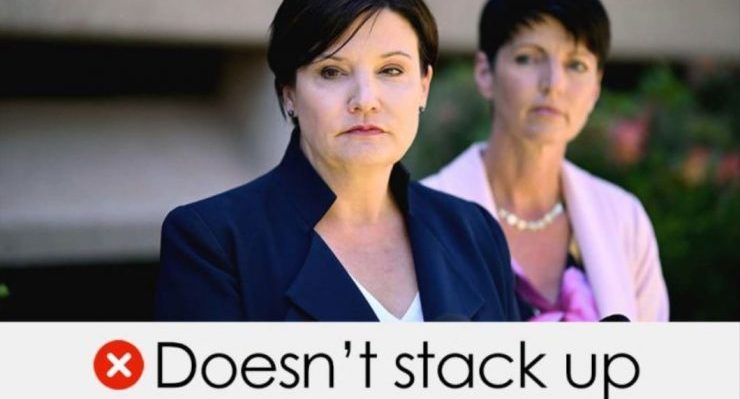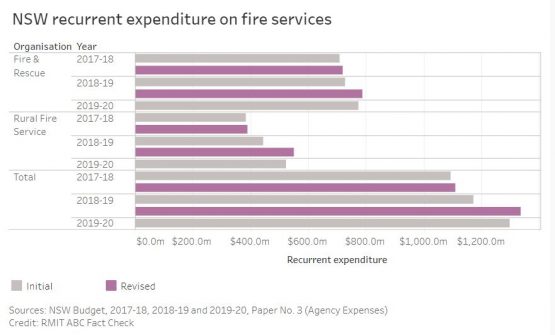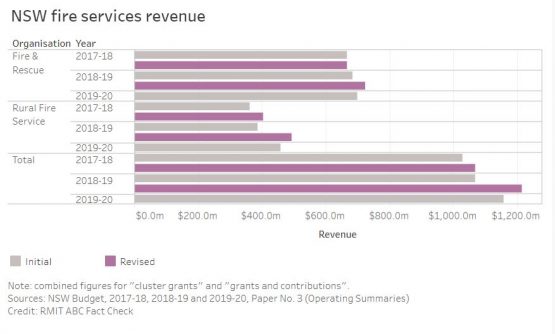
The claim
Catastrophic bushfires in NSW have seen tempers flare and set social media abuzz with claims funding for the state’s firefighters has been slashed.
NSW Labor, the firefighters’ union and the Young Greens each took to Facebook or Twitter with varying numbers to support their case.
Adding to the chorus, on November 15, 2019, NSW Labor leader Jodi McKay claimed:
“[The] government’s budget papers show that Fire and Rescue NSW and the Rural Fire Service combined are facing a $40 million budget cut — a cut that will mean fewer people on the ground to fight fires and less budget to do it with”.
NSW Premier Gladys Berejiklian has rejected any suggestion of cuts, arguing her government had “provided record funding to all of our frontline agencies in emergency services”.
So, is $40 million being cut from the NSW firefighting budget? RMIT ABC Fact Check investigates.
The verdict
McKay’s claim doesn’t stack up.
Her office told Fact Check the $40 million figure relied on numbers from the latest June budget.
However, McKay has compared initial estimates for the coming financial year, 2019-20, with revised estimates for the last. These numbers are not a like-for-like comparison, and the budget papers make clear the initial estimates are subject to change.
Her comparison ignores the fact that the revised 2018-19 estimates include more than $40 million in retrospective reimbursements for spending on natural disasters.
By contrast, the initial 2019-20 estimates do not include top-ups for disaster spending, which the fire agencies are almost certain to receive.
Recurrent funding was also particularly high in 2018-19 due to a change in workers compensation arrangements.
The change muddies the comparison with spending in this year, which may be lower due to a drop in insurance costs.
Importantly, lower spending on workers compensation would not affect the firefighting agencies’ ability to combat bushfires.
Experts consulted by Fact Check said budget outcomes inevitably varied from the initial estimates, meaning it was too early to say if funding had been cut.
Fact Check estimates that firefighting expenditure would need to grow by at least $39 million just to keep pace with inflation and population growth.
Who fights bushfires in NSW?
Several agencies fight and prevent bushfires in NSW, but McKay referred to just two: Fire and Rescue NSW and the NSW Rural Fire Service.
These account for the vast majority of firefighters in the state, with a smaller number coming from the NSW Forestry Corporation and the National Parks and Wildlife Service.
The Rural Fire Service is the state’s lead combat agency for fighting bushfires, and is a largely volunteer service.
Fire and Rescue NSW, whose mostly paid recruits are tasked with firefighting in the state’s cities and towns, also combats bushfires under the direction of its rural counterpart.
Who pays?
Government grants accounted for 92% of the two agencies’ combined revenue in 2017-18, according to the Productivity Commission’s latest estimates.
Of that, the majority originated from insurers (73.7%) and local councils (11.7%), who pay an emergency services levy legislated by the state government.
The NSW government collects and distributes the proceeds to the fire agencies.
The federal government may also deploy its own resources or reimburse certain natural disaster spending, but its direct contribution to the agencies’ budgets in 2017-18 was just 0.4%.
Looking ahead
McKay said the fire agencies “are facing” cuts, so Fact Check has assessed her claim on the basis of the current financial year, 2019-20.
A spokesman for McKay also told Fact Check via email that the $40 million figure came from the latest budget and related to recurrent expenditure for the current year.
Usually delivered in June, the state budget contains initial estimates for the approaching financial year. It also contains both initial and “revised” estimates for the year before.
John Wanna, a professor of public administration with Australian National University, told Fact Check that budgets reflect what governments intend to do, but there was “always variation” between this and the end-of-year figures.
David Hayward an emeritus professor at RMIT University, said initial and revised estimates were not a like-for-like comparison, so “until that final number comes in you just can’t make a call” on whether there had been cuts.
Checking the numbers
Hayward said revenue and expenditure (income and spending) were both important to consider, but since lower expenses in one year may be due to fewer fires, revenue was the “real issue”.
“What matters is that they can deploy resources when needed to fight and prevent fires,” he said.
Revenue and expenditure figures are presented in different parts of Budget Paper No. 3, with recurrent and capital expenditure treated separately.
Capital expenditure
Capital expenditure can include large, one-off purchases whose costs are unevenly spread. Equally, the benefits are typically spread over many successive years.
As the budget papers show, capital spending for the two agencies was $61.5 million in 2017-18, $146.7 million in 2018-19 and, at the start of the year, estimated to be $68.3 million in 2019-20.
In Parliament on November 13, 2019, Treasurer Dominic Perrottet said the NSW government had “made critical, large-scale and one-off investments in emergency services” over three previous budgets.
For the Rural Fire Service, this included $21 million for its new headquarters that were opened last year, and, Berejiklian told Parliament on November 14, $23 million for a new training academy.
During budget estimates hearings in September, Fire and Rescue NSW commissioner Paul Baxter said spending in 2019-20 would be lower due to the previous year’s “enhanced capital budgets”, including $7 million for aircraft, $9.8 million for equipment at a new training academy and $17.5 million for a program to improve emergency service communications.
This spending can bring ongoing benefits, regardless of when the cost was incurred.
Indeed, one reason for the big outlay in 2018-19 was because the government spent $26.3 million on three new planes for the Rural Fire Service, including a large air tanker. The government’s half-yearly budget review released in December 2018 said this spending, which had not been foreshadowed in the June budget, was “in preparation for the 2019-20 bushfire season”.
Fact Check has not included capital expenditure in its assessment, as it does not consider that, for example, the absence of extra planes in subsequent years would equate to, in McKay’s words, “fewer people on the ground to fight fires and less budget to do it with”.
However, the increase in capital expenditure over 2018-19, from that year’s original estimate, underlines that the initial funding figures in any budget are subject to review.

So, what happened to recurrent expenditure?
The budget papers show recurrent spending on the two firefighting services in 2018-19 was initially estimated to be $1.174 billion. By the time this year’s budget was handed down in June, this figure had been revised upwards by $164.7 million (14%), to $1.338 billion.
At the start of 2019-20, spending for the coming year was estimated to be $1.299 billion.
That figure is $39.6 million lower than the previous year’s revised estimate, which, while not a like-for-like comparison, accords with McKay’s claim.
But the revised estimates also show recurrent spending in the previous year, 2018-19, was especially high.
Compared to the revised figure for 2017-18, it jumped by $228.9 million, or 20.6%.
Wanna said that while the $39.6 million decrease appeared to be a cut, the spike in 2018-19 suggested this was the “aberrant figure”.
Several things contributed to the large spending that year.

What’s behind the spike?
Both fire agencies told Fact Check the jump in 2018-19 recurrent expenditure was largely due to a November 2018 law change that made it easier for firefighters to claim workers compensation for certain cancers.
After the change, the December half-yearly budget review said it was expected to add $114.9 million to government expenses in 2018-19, and $643 million over the four-year forward estimates.
A Fire and Rescue NSW spokesman told Fact Check the change added $34.6 million to the agency’s expenses in 2018-19.
Being a new impost, he said, insurance spending “was higher in the first year to cover retrospective claims”.
A Rural Fire Service spokesman said the change increased his agency’s expenditure by roughly $70 million in 2018-19.
Its annual report, released later, put the figure at $102 million ($11 million for staff and $91 million for volunteers).
Still, the budget does not show by how much workers compensation is forecast to change in 2019-20.
The insurer for volunteer firefighters, iCare, wrote in its 2018-19 annual report that the legislative change had created “[u]ncertainties around claim numbers” that could “materially alter future reported liabilities”.
And the Fire and Rescue spokesman said spending related to the change was “revised downward for the 2019-20 budget based on most recent estimates”.
Even if spending on workers compensation falls in 2019-20, this would not represent, as McKay put it, “a cut that will mean fewer people on the ground to fight fires and less budget to do it with”.
Disaster spending
During the recent bushfires, Rural Fire Service Commissioner Shane Fitzsimmons said he had provided the government with information for use during budget estimates that refuted the charge of budget cuts.
The minister overseeing his agency, David Elliott, told the NSW parliament in September 2019 the agency’s budget “was not cut by $26.7 million”.
This was a reference to Rural Fire Service’s portion of the $39.6 million difference in recurrent expenditure referred to above.
He said the 2018-19 revised estimates were higher because they contained retrospective funding for natural disasters, while the 2019-20 estimates did not.
“The initial budget in each year does not include any budget for natural disaster expenses, as the level of natural disasters in any given year is unknown and unpredictable,” he told Parliament.
Indeed, once fire agencies have exhausted their operating budgets, they can access further funding from the state’s Disaster Relief Account.
A spokesman for the Office of Emergency Management told Fact Check the account “works on a reimbursement model where the agencies first spend the money from their own budget and are reimbursed 100% … for all eligible expenditure”.
He said the NSW firefighting agencies collectively received over $40 million from the fund in 2018-19.
Annual reports released after McKay made her claim show the Rural Fire Service received $39.8 million and Fire and Rescue NSW received $1.4 million.
In addition, earlier annual reports show the Rural Fire Service has received disaster funding every year for at least the previous five years ($134.3 million in 2013-14, $46 million in 2014-15, $46 million in 2015-16, $30 million in 2016-17 and $53 million in 2017-18).
So far this financial year, the government has already declared two natural disasters relating to bushfires in northern NSW, making it almost certain that the 2019-20 recurrent budget will be revised upwards.
The revenue figures
Government revenue to each agency appears in their budget operating summary.
These figures tell a similar story to recurrent expenditure.
Revenue for the two agencies was forecast to drop by $57.9 million (4.8%) in 2019-20 compared with the previous year’s revised estimates.
But the revised 2018-19 figure includes reimbursements for natural disasters, while the 2019-20 figure does not.
And, coinciding with the workers compensation change, revenue spiked in 2018-19, coming in $146.9 million (13.8%) higher than in 2017-18.

Keeping pace
Experts consulted by Fact Check noted the need for spending to at least keep pace with inflation, or rising prices, and population growth.
In 2019-20, the budget showed, the population of NSW was projected to grow by 1.7%.
According to the consumer price index, prices were expected to grow by 2%, though the Productivity Commission’s preferred index for government services shows inflation has averaged at a much lower 1.22% per annum over the five years to 2017-18.
With population growth, then, recurrent expenditure on NSW fire services would need to grow by between $39 million and $50 million in 2019-20, compared with the previous year’s $1,338.2 million.
Hayward said other factors — such as climate change, property values and cladding use — all suggested funding for firefighting “needs a big boost to maintain the real level of resources to keep people and property safe”, but said that comprehensive data was not available to put a value on it.
University of Western Australia’s Dr Veronique Florec, an economist and project leader with the Bushfire and Natural Hazards CRC, said she was not aware of an index to measure the rising costs of firefighting.
A 2014 study by Deloitte Access Economics estimated that the annual cost of bushfire damage to NSW would grow from $43 million in 2014 to $50 million in 2020 after taking inflation into account, based solely on population growth and increased infrastructure density.
Another 2013 study conducted for the United Firefighters Union of Australia suggested that, between 2012 and 2020, the number of professional firefighters in NSW would need to grow by at least 24% to keep pace with increasing fire intensity, though this did not consider the effect of longer fire seasons.
Principal researcher: David Campbell
factcheck@rmit.edu.au
Sources
- Jodi McKay, Interview with the Daily Liberal, November 15, 2019
- Young Greens, Facebook post, November 10, 2019
- Fire Brigades Employees Union, Media release, November 11, 2019
- NSW Labor, Tweet, November 15, 2019
- Gladys Berejiklian, Interview with RN Breakfast, November 12, 2019
- Shane Fitzsimmons, Media conference, November 11, 2019
- Productivity Commission, Report on government services 2019 (fire services)
- Rural Fire Service, Annual reports, 2013-14 to 2018-19
- Fire & Rescue NSW, Annual reports, 2016-17 to 2018-19
- NSW Government, Emergency services levy, accessed November 18, 2019
- NSW Budget (2017-18), Paper No. 3, Tables: Expenses, Operating Summaries
- NSW Budget (2018-19), Paper No. 3, Tables: Expenses, Operating Summaries
- NSW Budget (2019-20), Paper No. 3, Tables: Expenses, Operating Summaries
- NSW Midyear Budget Review (2018-19)
- Rural Fire Service, Budget estimates 2019-20 responses to questions on notice
- NSW Treasury, Guidelines disaster account reimbursements
- Productivity Commission, Natural disaster funding, December 17, 2014
- Parliamentary Library, Emergency management quick guide, July 16, 2019
- Productivity Commission, Report on government services 2019 (statistical concepts)
- Deloitte Access Economics, Scoping Study on a Cost Benefit Analysis of Bushfire Mitigation, May 2014
- National Institute of Economic and Industry Research (NIEIR), Firefighters and climate change: final report, February 2013
- Climate Council, Climate change and the NSW bushfire threat, 2014







NSW Labor, the firefighters’ union and the Young Greens each took to Facebook or Twitter with varying numbers to support their case.
And so did Crikey on Nov 11, 2019: https://uat.crikey.com.au/2019/11/11/nsw-bushfires-budget-cut/
You should note that in the article and whether that Nov 11 Crikey article is still factually correct.
You can argue about the vagaries of funding figures, but I believe staff numbers and experience have been slashed for the National parks fire personnel, and that together with a shrinking cool weather opportunity window, means less back-burning and fire breaks being done.
And small increases in normal funding do not cut the mustard when crisis is striking like it is now.
PS I reckon we have pushed the volunteers way too far already, people should not be sacrificing their holidays, long service leave, and employment security so governments can save money and apply endless efficiency dividends.
The number of paid firefighters and fire-trained defence personnel has to increase rapidly, together with a lot more specialist aircraft, to meet the new reality of fire risk – and that is a Federal responsibility in my view, with independent oversight by experts rather than IPA driven political windbags.
Could not agree more fairmind.
Why in hell can’t the Army and Navy be trained in bushfire fighting. The Navy are well trained in shipboard firefighting it’s not hard to include a bushfire component, then they could work alongside the volunteers. The army might need a bit more training but firefighting is not that hard in the bush.
Why can’t the Airforce use some of the transport aircraft for firefighting? Hercules aircraft are modified and used in the USA, 737 aircraft are commonly used. The conversion can be removed and fitted as required. God forbid that any pollie might have to go in a civilian aircraft to go on some junket.
I did hear our revered leader Scummo saying this morning that this was not possible, well that is BS.
More can be done for the Vollies also. I was many years in the WA bushfire Brigade and loved the task, the feeling of a job done and the many thank yous from people was payment enough. But some recognition , for example paying the fire services levy used to irk us, we were the bloody Fire Service in our shire. Using our own transport to get to the fireground to save time . Instead of the firetruck having to come back to the station. No compensation was claimable for that or the purchase of equipmen that the Govt. wouldn’t or was very tardy in supplying.
I believe some states gave Free admission to National Parks for Vollies but WA gave nothing. The only time any recognition came from a pollie was when they came up for a Photo Opp and told us how we were heroes ( we didn’t see it like that ) then shot through.